Design and Realization of a Multi-Band, High-Gain, and High-Isolation MIMO Antenna for 5G mmWave Communications
Abstract
1. Introduction
- Compact antenna design, measuring a mere 50 × 50 × 0.787 mm3 (4.67λo × 4.67λo × 0.73λo), delivers good performance, catering to meet the needs of modern communication devices constrained by limited space.
- Operates within the tri-band 28, 35, and 38 GHz, offering the promise of expedited and more efficient wireless communication solutions.
- Features 34.5, 22, and 30 dB isolation between its ports, by which it effectively minimizes interference, ensuring the clarity and strength of the signals transmitted.
- Achieves high gains of 9.6, 7.8, and 13.7 dBi in the tri-band, respectively, which enhances communication range and quality, facilitating improved transmission capabilities.
2. Design and Analysis
2.1. Single Antenna Element
- E-plane: 9 dBi gain, main lobe at θ = 4° (beamwidth = 50.8°).
- H-plane: 9.3 dBi gain, main lobe at θ = 0° (beamwidth = 27.3°).
- E-plane: 5.9 dBi gain, main lobe at θ = 42° (beamwidth = 36.9°).
- H-plane: 5.7 dBi gain, main lobe at θ = 29° (beamwidth = 26.2°).
- E-plane: Weaker gain pattern.
- H-plane: 11.2 dBi gain, main lobe at θ = 24° (beamwidth = 21.4°).
2.2. Four-Element MIMO Antenna
2.3. MIMO Assessment
- E-plane: 7.7 dBi gain, main lobe: θ = 16°, beamwidth: 60.7°.
- H-plane: 9.8 dBi gain, main lobe: θ = 7°, beamwidth: 25°.
- E-plane: 6.7 dBi gain, main lobe: θ = 42°, beamwidth: 19.6°.
- H-plane: 5.2 dBi gain, main lobe: θ = 19°, beamwidth: 26°.
- E-plane: reduced gain performance.
- H-plane: 13.8 dBi gain, main lobe: θ = 26°, beamwidth: 12°.
3. Measurement Results
4. Conclusions
Author Contributions
Funding
Institutional Review Board Statement
Informed Consent Statement
Data Availability Statement
Acknowledgments
Conflicts of Interest
References
- Federal Communications Commission. Report, order, and further notice of proposed rulemaking. Matter Revis. Comm. Rules Ensure Compat. Enhanc. 2016, 911, 94–102. [Google Scholar]
- Attiah, M.L.; Isa, A.A.; Zakaria, Z.; Abdulhameed, M.K.; Mohsen, M.K.; Ali, I. A survey of mmWave user association mechanisms and spectrum sharing approaches: An overview, open issues and challenges, future research trends. Wirel. Netw. 2020, 26, 2487–2514. [Google Scholar] [CrossRef]
- Mandloi, M.; Gurjar, D.; Pattanayak, P.; Nguyen, H. 5G and Beyond Wireless Systems; Springer: Berlin, Germany, 2021. [Google Scholar]
- Aboagye, S.; Saeidi, M.A.; Tabassum, H.; Tayyar, Y.; Hossain, E.; Yang, H.C.; Alouini, M.S. Multi-band wireless communication networks: Fundamentals, challenges, and resource allocation. IEEE Trans. Commun. 2024, 72, 4333–4383. [Google Scholar] [CrossRef]
- JY The role of millimeter-wave technologies in 5G/6G wireless communications. IEEE J. Microw. 2021, 1, 101–122. [CrossRef]
- Daraseliya, A.; Korshykov, M.; Sopin, E.; Moltchanov, D.; Andreev, S.; Samouylov, K. Coexistence analysis of 5G NR unlicensed and WiGig in millimeter-wave spectrum. IEEE Trans. Veh. Technol. 2021, 20, 11721–11735. [Google Scholar] [CrossRef]
- Xu, X.; Chen, Q.; Jiang, H.; Huang, J. Millimeter-wave NR-U and WiGig coexistence: Joint user grouping, beam coordination, and power control. IEEE Trans. Wirel. Commun. 2021, 21, 2352–2367. [Google Scholar] [CrossRef]
- Alnemr, F.; Ahmed, M.F.; Shaalan, A.A. A compact 28/38 GHz MIMO circularly polarized antenna for 5 G applications. J. Infrared Millim. Terahertz Waves 2021, 42, 338–355. [Google Scholar] [CrossRef]
- Sabek, A.R.; Ali, W.A.; Ibrahim, A.A. Minimally coupled two-element MIMO antenna with dual band (28/38 GHz) for 5G wireless communications. J. Infrared Millim. Terahertz Waves 2022, 43, 335–348. [Google Scholar] [CrossRef]
- Cuneray, K.; Akcam, N.; Okan, T.; Arican, G.O. 28/38 GHz dual-band MIMO antenna with wideband and high gain properties for 5G applications. AEU-Int. J. Electron. Commun. 2023, 1, 154553. [Google Scholar] [CrossRef]
- Ali, S.A.; Wajid, M.; Kumar, A.; Alam, M.S. Design challenges and possible solutions for 5G SIW MIMO and phased array antennas: A review. IEEE Access 2022, 10, 88567–88594. [Google Scholar] [CrossRef]
- Tiwari, P.; Gahlaut, V.; Kaushik, M.; Rani, P.; Shastri, A.; Singh, B. Advancing 5G connectivity: A comprehensive review of MIMO antennas for 5G applications. Int. J. Antennas Propag. 2023, 2023, 5906721. [Google Scholar] [CrossRef]
- Wang, Z.; Zhang, J.; Du, H.; Wei, E.I.; Ai, B.; Niyato, D.; Debbah, M. Extremely large-scale MIMO: Fundamentals, challenges, solutions, and future directions. IEEE Wirel. Commun. 2023, 31, 117–124. [Google Scholar] [CrossRef]
- Raj, T.; Mishra, R.; Kumar, P.; Kapoor, A. Advances in MIMO antenna design for 5G: A comprehensive review. Sensors 2023, 12, 6329. [Google Scholar] [CrossRef]
- Jemaludin, N.H.; Al-Gburi, A.J.; Elabd, R.H.; Saeidi, T.; Akbar, M.F.; Ibrahim, I.M.; Zakaria, Z. A comprehensive review on MIMO antennas for 5G smartphones: Mutual coupling techniques, comparative studies, SAR analysis, and future directions. Results Eng. 2024, 10, 102712. [Google Scholar] [CrossRef]
- Kamal, M.M.; Yang, S.; Ren, X.; Altaf, A.; Kiani, S.H.; Anjum, M.R.; Iqbal, A.; Asif, M.; Saeed, S.I. Infinity Shell Shaped MIMO Antenna Array for mm-Wave 5G Applications. Electronics 2021, 10, 165. [Google Scholar] [CrossRef]
- Sehrai, D.A.; Abdullah, M.; Altaf, A.; Kiani, S.H.; Muhammad, F.; Tufail, M.; Irfan, M.; Glowacz, A.; Rahman, S. A Novel High Gain Wideband MIMO Antenna for 5G Millimeter Wave Applications. Electronics 2020, 9, 1031. [Google Scholar] [CrossRef]
- Tiwari, R.N.; Sharma, D.; Singh, P.; Kumar, P. A flexible dual-band 4 × 4 MIMO antenna for 5G mm-wave 28/38 GHz wearable applications. Sci. Rep. 2024, 14, 14324. [Google Scholar] [CrossRef] [PubMed]
- Wang, L.; Li, H.; Shi, Y.; Chen, M.; Li, C.; Wang, H.; Zheng, L. An elliptical dual-band antenna with crescent slot for 5G mm Wave applications. J. Phys. Conf. Ser. 2024, 2807, 012033. [Google Scholar] [CrossRef]
- Sghaier, N.; Belkadi, A.; Hassine, I.B.; Latrach, L.; Gharsallah, A. Millimeter-wave dual-band MIMO antennas for 5G wireless applications. J. Infrared Millim. Terahertz Waves 2023, 44, 297–312. [Google Scholar] [CrossRef]
- Sharma, P.; Tiwari, R.N.; Singh, P.; Kumar, P.; Kanaujia, B.K. MIMO antennas: Design approaches, techniques and applications. Sensors 2022, 22, 7813. [Google Scholar] [CrossRef]
- Kumar, P.; Ali, T.; Pai, M.M. Electromagnetic metamaterials: A new paradigm of antenna design. IEEE Access 2021, 22, 18722–18751. [Google Scholar] [CrossRef]
- Ketzaki, D.A.; Yioultsis, T.V. Metamaterial-based design of planar compact MIMO monopoles. IEEE Trans. Antennas Propag. 2013, 30, 2758–2766. [Google Scholar] [CrossRef]
- Alsaab, N.; Alhassoon, K.; Alsaleem, F.; Alsunaydih, F.N.; Madbouly, S.O.; Khaleel, S.A.; Ameen, A.M.; Shaban, M. High-Performance Series-Fed Array Multiple-Input Multiple-Output Antenna for Millimeter-Wave 5G Networks. Sensors 2025, 25, 1036. [Google Scholar] [CrossRef]
- Shaban, M. Development and Implementation of High-Gain, and High-Isolation Multi-Input Multi-Output Antenna for 5G mmWave Communications. Telecom 2025, 6, 14. [Google Scholar] [CrossRef]
- Alsalman, A.; Alhumaid, A.; Alnogithan, A.; Hamad, E.K.; Shaban, M. Reconfigurable 28/38 GHz wideband and high isolation MIMO antenna for advanced mmWave applications. J. Electr. Eng. 2024, 75, 467–483. [Google Scholar] [CrossRef]
- Shaban, M. Design and Modeling of a Reconfigurable Multiple Input, Multiple Output Antenna for 24 GHz Radar Sensors. Modelling 2025, 6, 2. [Google Scholar] [CrossRef]
- Alibakhshikenari, M.; Virdee, B.S.; Shukla, P.; See, C.H.; Abd-Alhameed, R.A.; Falcone, F.; Quazzane, K.; Limiti, E. Isolation enhancement of densely packed array antennas with periodic MTM-photonic bandgap for SAR and MIMO systems. IET Microw. Antennas Propag. 2020, 14, 183–188. [Google Scholar] [CrossRef]
- Alibakhshikenari, M.; Virdee, B.S.; See, C.H.; Abd-Alhameed, R.A.; Falcone, F.; Limiti, E. Surface wave reduction in antenna arrays using metasurface inclusion for MIMO and SAR systems. Radio Sci. 2019, 54, 1067–1075. [Google Scholar] [CrossRef]
- Alibakhshikenari, M.; Khalily, M.; Virdee, B.S.; See, C.H.; Abd-Alhameed, R.A.; Limiti, E. Mutual-coupling isolation using embedded metamaterial EM bandgap decoupling slab for densely packed array antennas. IEEE Access 2019, 9, 51827–51840. [Google Scholar] [CrossRef]
- Wang, H.; Xiao, P.; Li, X. Channel parameter estimation of mmWave MIMO system in urban traffic scene: A training channel-based method. IEEE Trans. Intell. Transp. Syst. 2022, 25, 754–762. [Google Scholar] [CrossRef]
- Wang, H.; Xu, L.; Yan, Z.; Gulliver, T.A. Low-complexity MIMO-FBMC sparse channel parameter estimation for industrial big data communications. IEEE Trans. Ind. Inform. 2020, 17, 3422–3430. [Google Scholar] [CrossRef]
- Khalid, M.; Iffat Naqvi, S.; Hussain, N.; Rahman, M.; Fawad Mirjavadi, S.S.; Khan, M.J.; Amin, Y. 4-Port MIMO antenna with defected ground structure for 5G millimeter wave applications. Electronics 2020, 9, 71. [Google Scholar] [CrossRef]
- Ramanathan, S.; Maria, A.B. A Compact Four-Element MIMO Antenna for 5 G Millimeter-Wave (37–39 GHz) Applications. J. Infrared Millim. Terahertz Waves 2024, 23, 604–620. [Google Scholar] [CrossRef]
- Abbasi, N.A.; Virdee, B.; Din, I.U.; Ullah, S.; Althuwayb, A.A.; Rashid, N.; Soruri, M.; See, C.H. High-Isolation Array Antenna Design for 5G mm-Wave MIMO Applications. J. Infrared Millim. Terahertz Waves 2025, 46, 12. [Google Scholar] [CrossRef]
- Farahat, A.E.; Hussein, K.F. Dual-band (28/38 GHz) wideband MIMO antenna for 5G mobile applications. IEEE Access 2022, 10, 32213–32223. [Google Scholar] [CrossRef]
- Marzouk, H.M.; Ahmed, M.I.; Shaalan, A.A. Novel dual-band 28/38 GHz MIMO antennas for 5G mobile applications. Prog. Electromagn. Res. C 2019, 93, 103–117. [Google Scholar] [CrossRef]
- Sghaier, N.; Belkadi, A.; Malleh, M.A.; Latrach, L.; Hassine, I.B. Design and Analysis of a Compact MIMO Antenna for 5G mmWave N257, N260, and N262 Band Applications. J. Infrared Millim. Terahertz Waves 2024, 45, 247–264. [Google Scholar] [CrossRef]
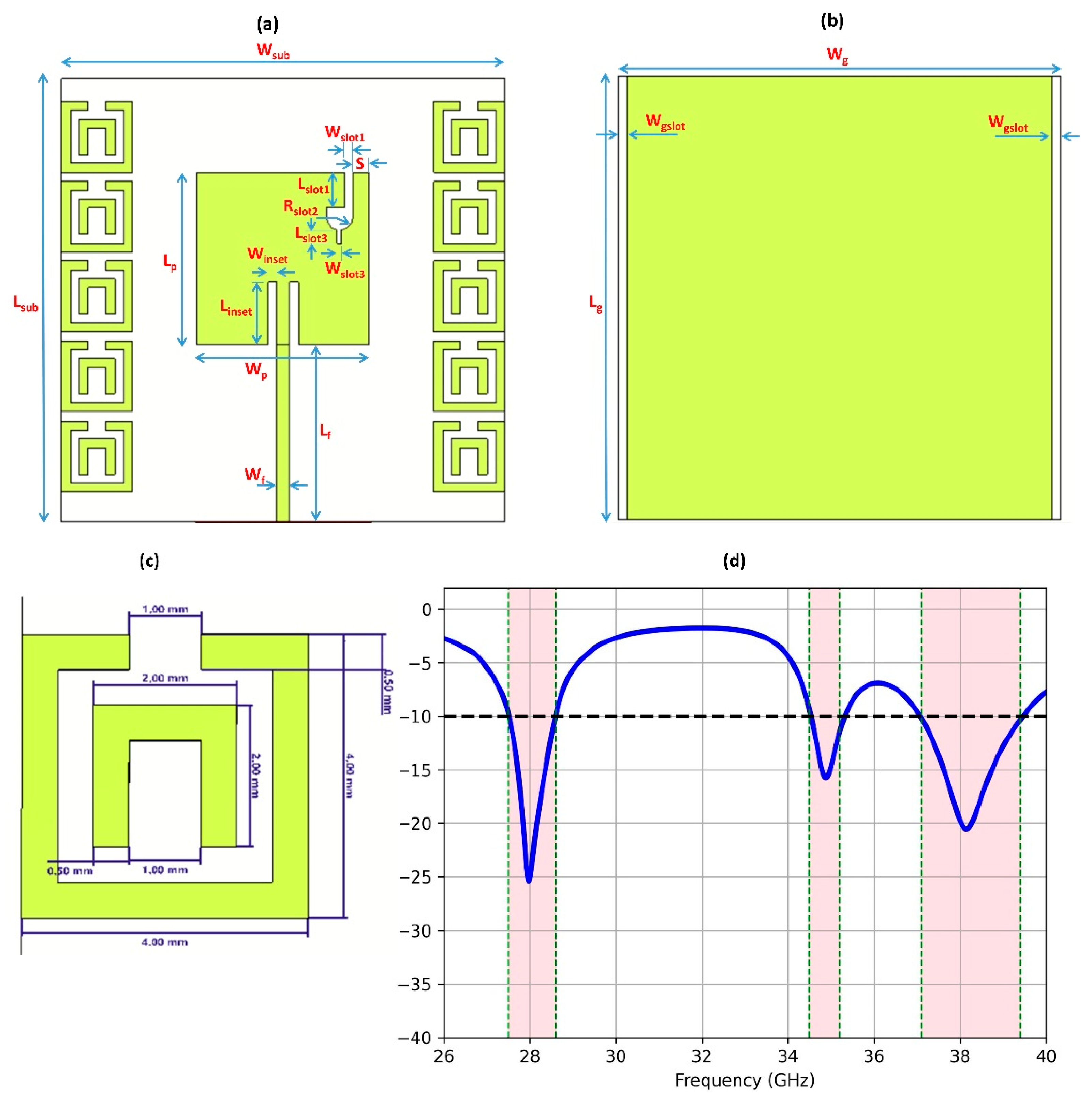
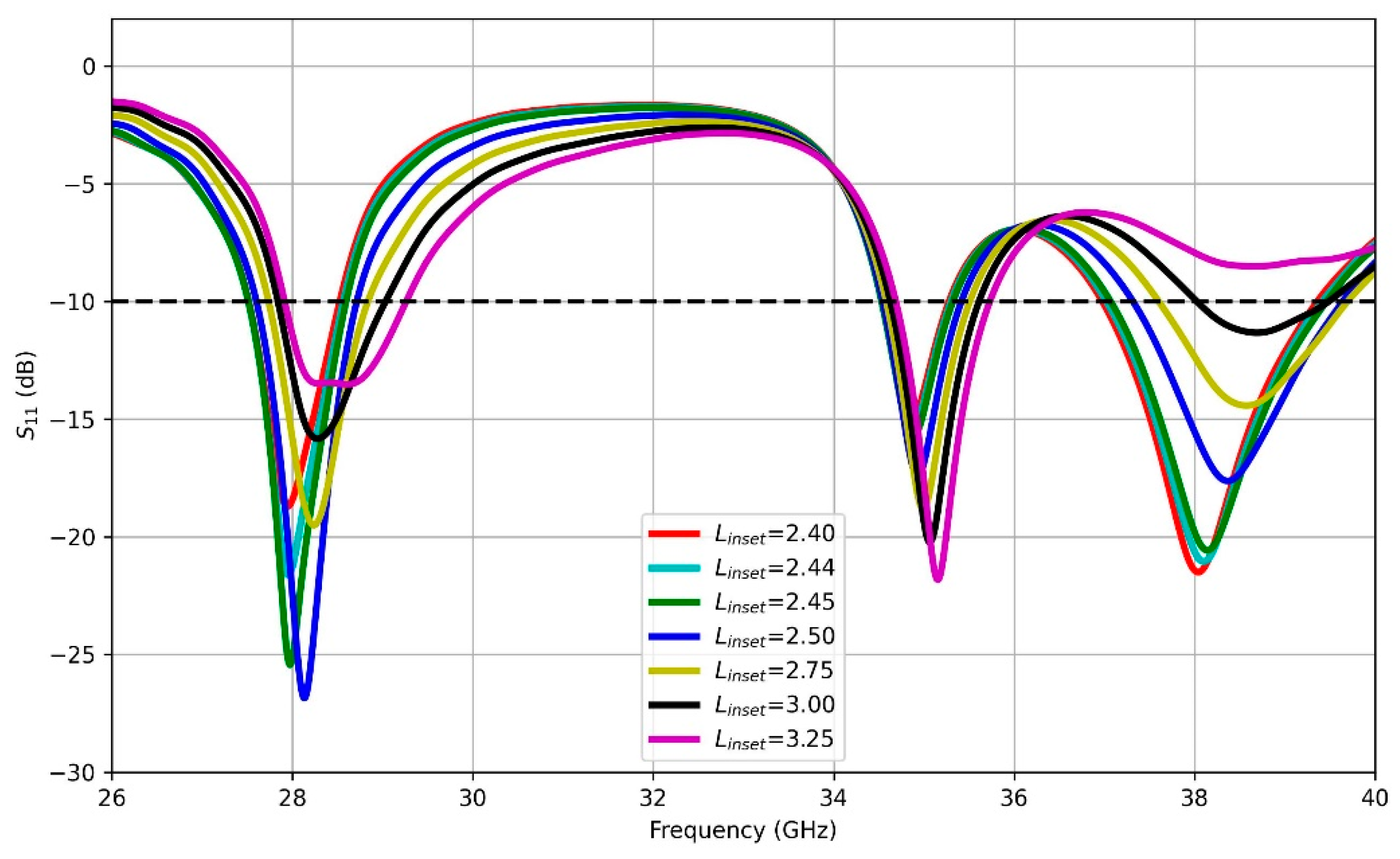
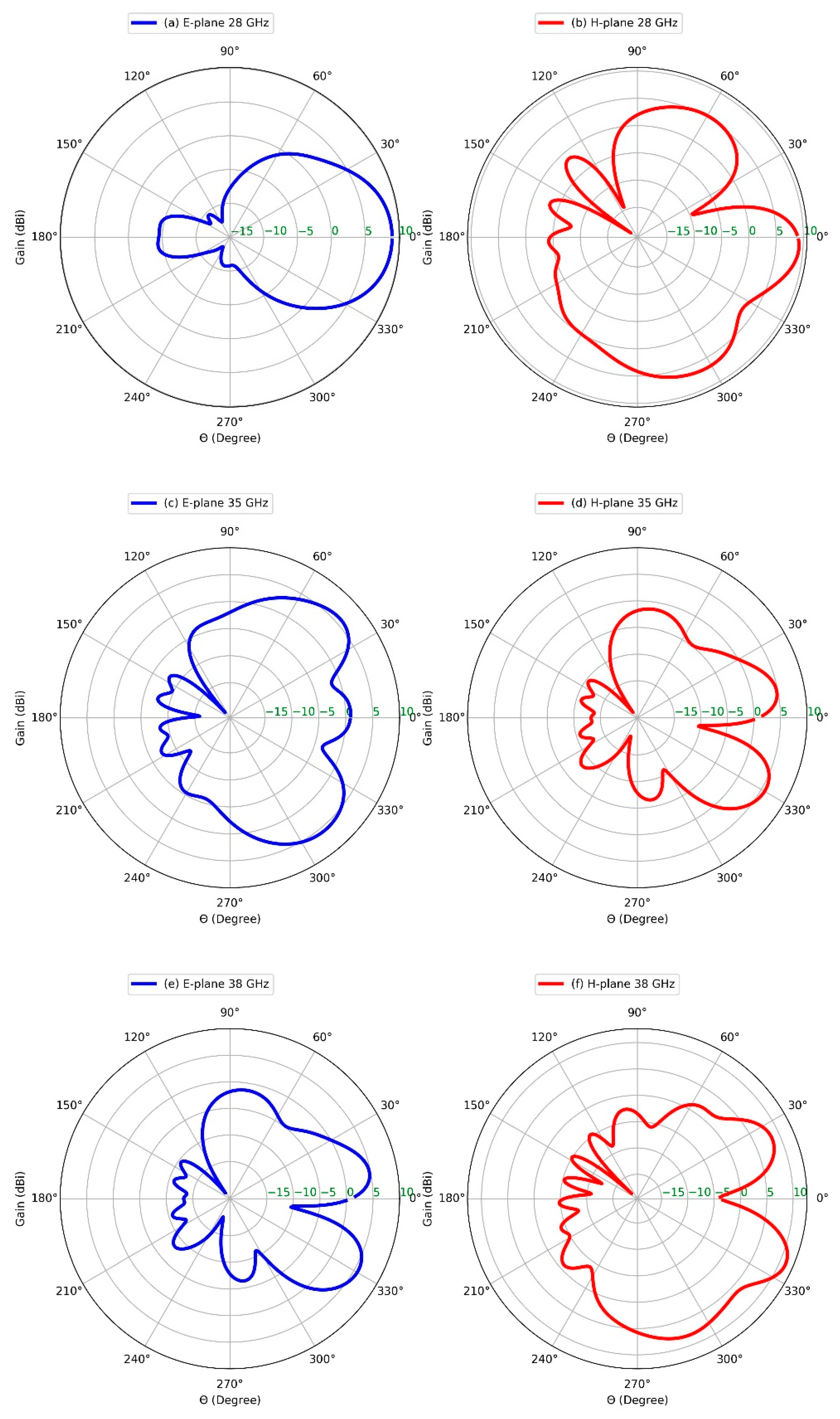
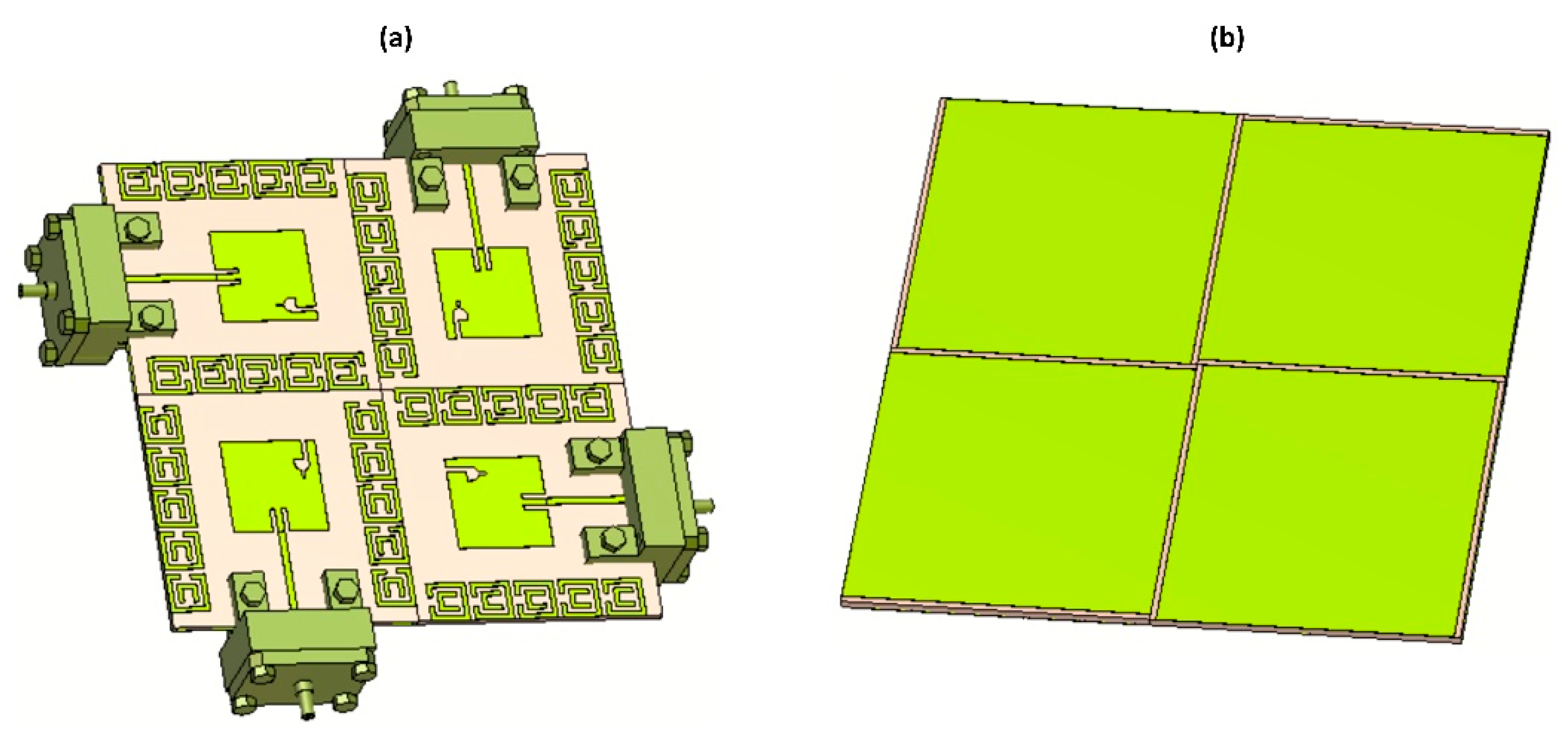


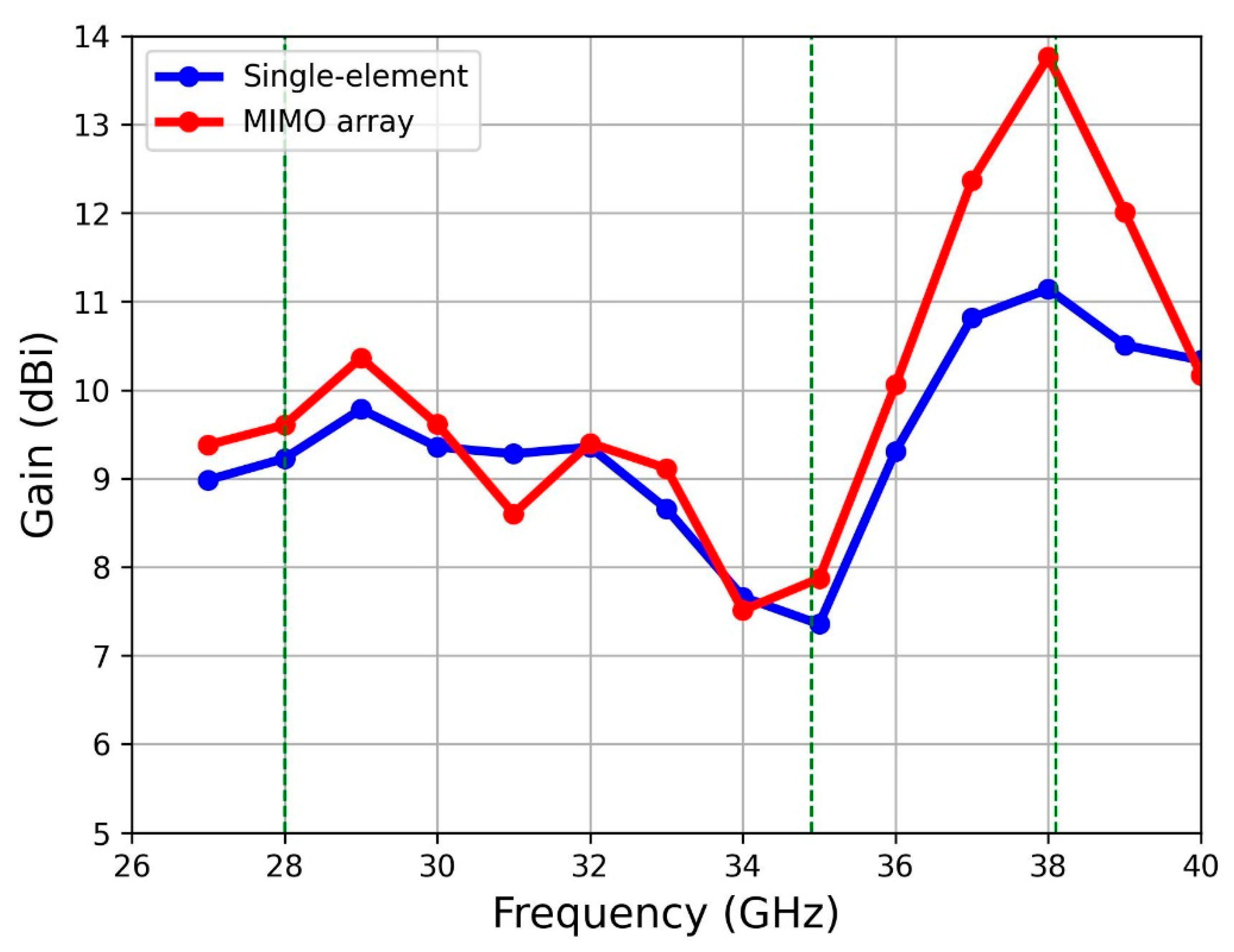
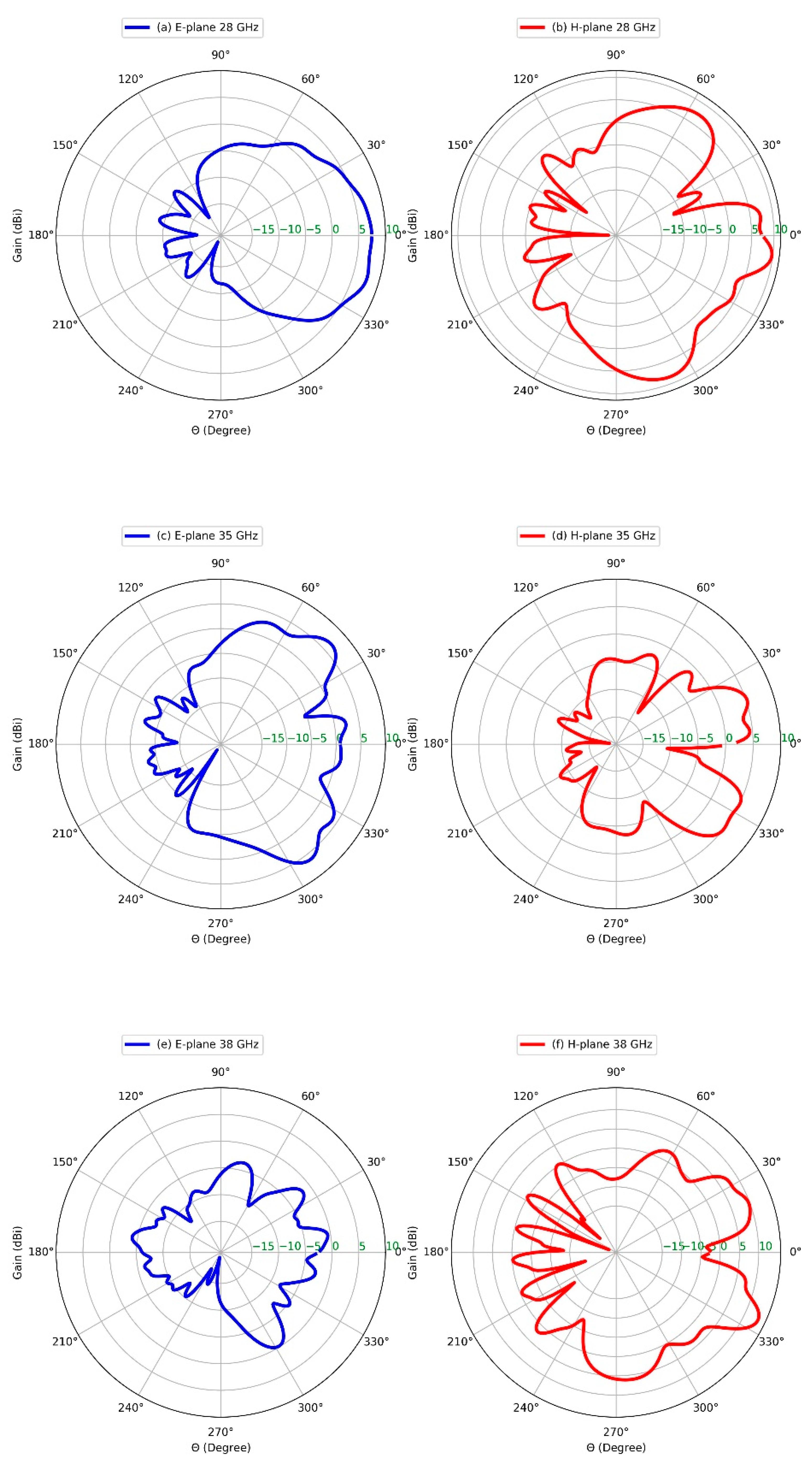
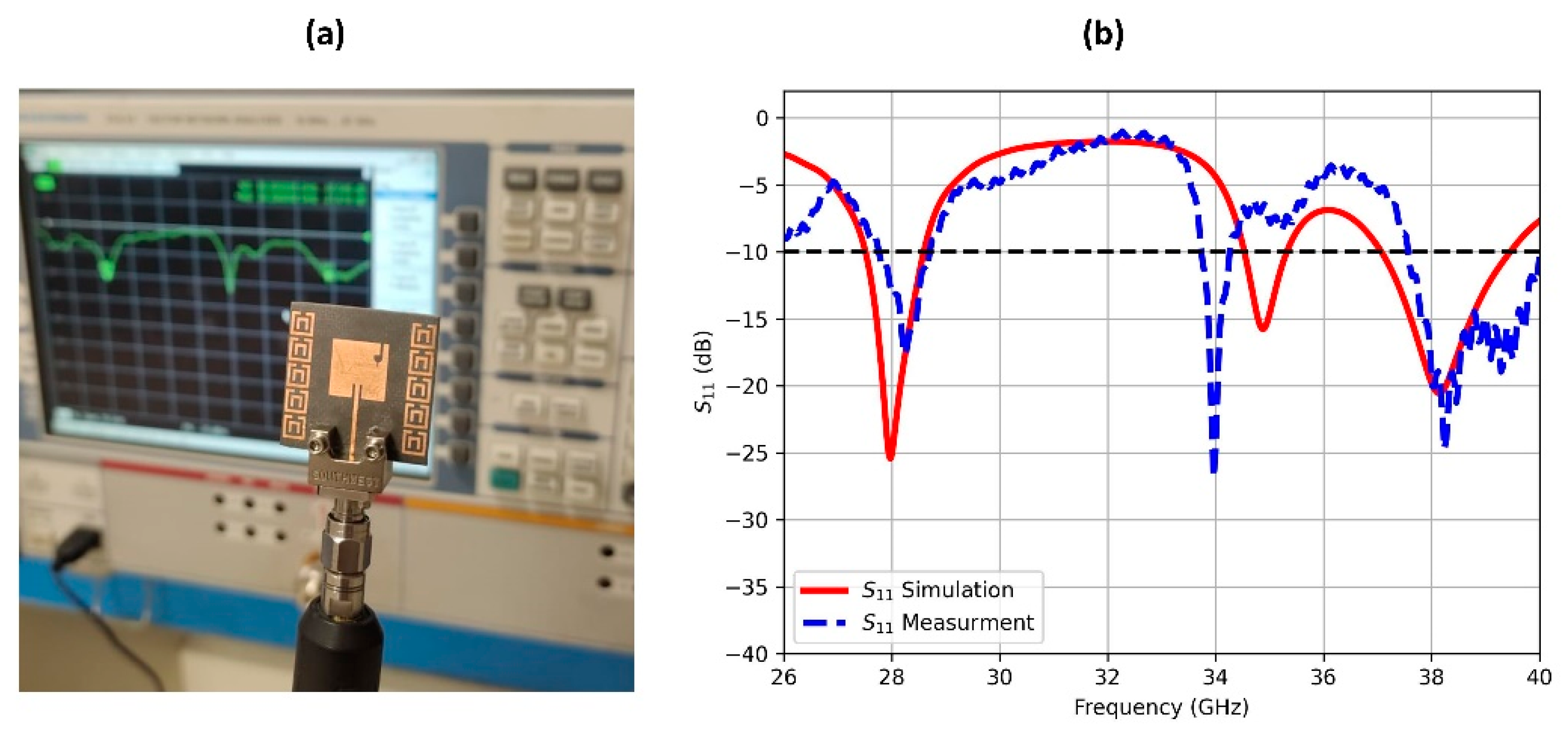
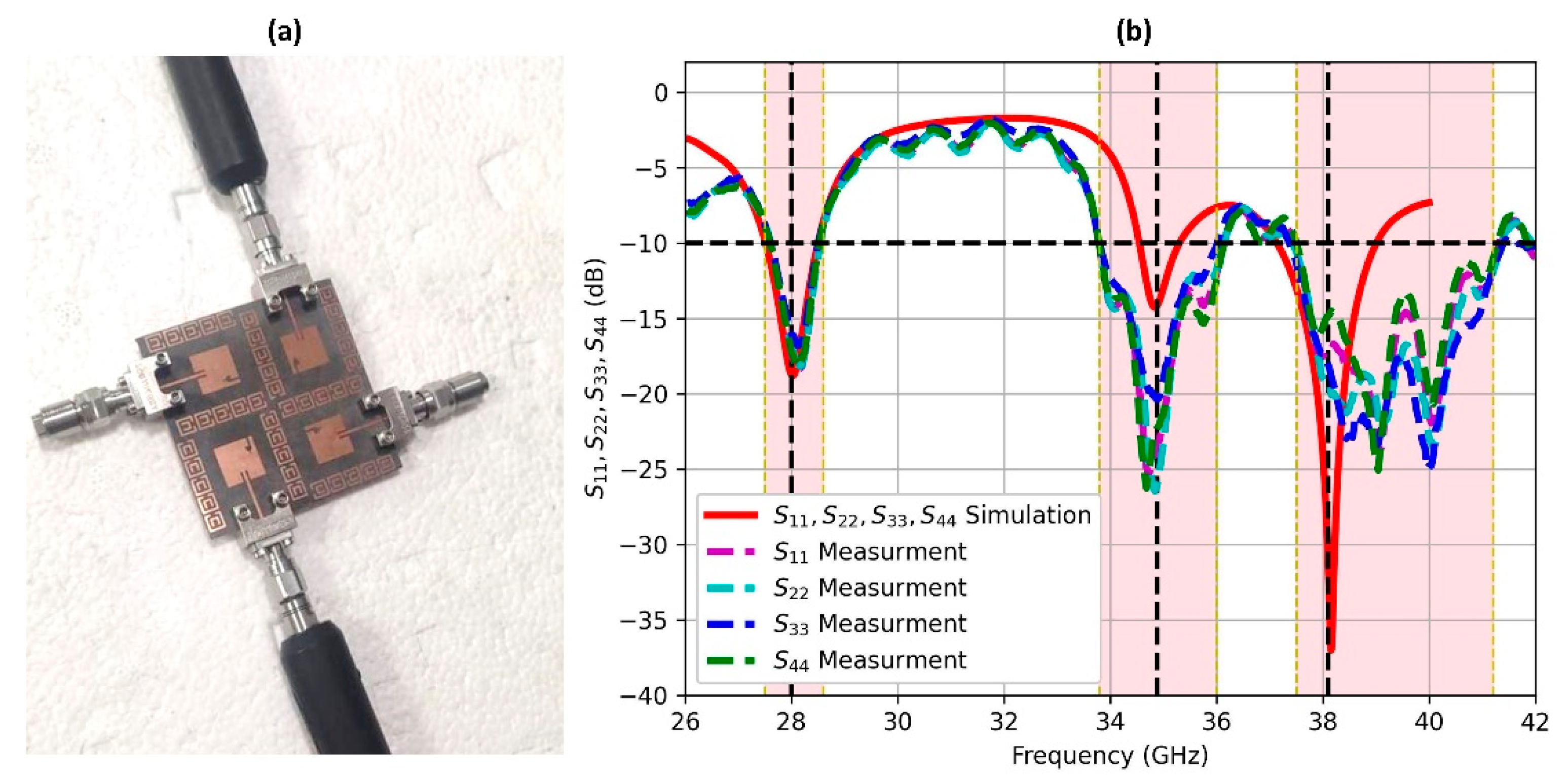
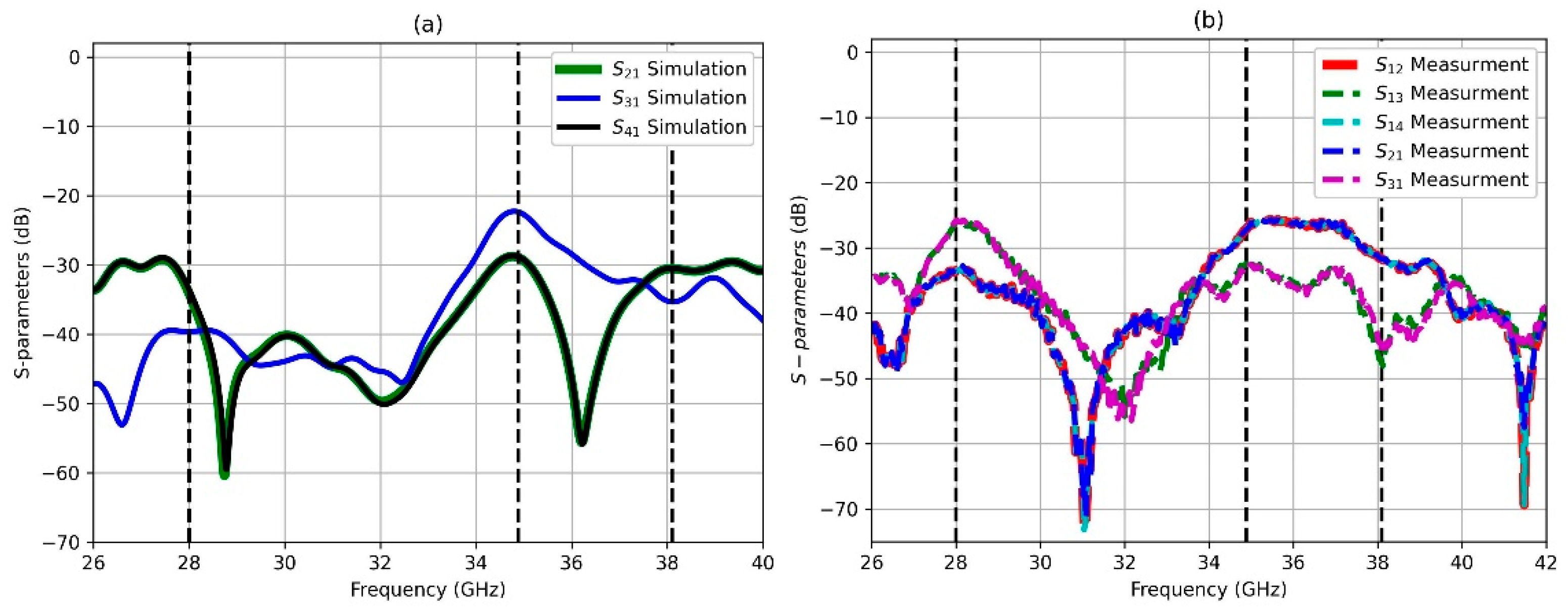
| Parameter | Value (mm) | Parameter | Value (mm) |
|---|---|---|---|
| Wp | 9.70 | Wf | 0.70 |
| Lp | 9.70 | Lf | 10.0 |
| Wslot1 | 0.50 | Winset | 0.50 |
| Lslot1 | 2.00 | Linset | 2.50 |
| Rslot2 | 0.60 | Wsub,Lsub | 25.0 |
| Wslot3 | 0.25 | h | 0.787 |
| Lslot3 | 0.76 | Wg,Lg | 25.0 |
| S | 0.93 | Wgslot | 0.50 |
| Reference No. | Frequency (GHz) | Ports | Dimensions (λo and mm2) | Bandwidth (GHz) | Gain (dBi) | Isolation (dB) |
|---|---|---|---|---|---|---|
| [33] | 28 | 4 | 2.8λo × 3.3λo (30 × 35) | 4.1 | 8.3 | 22 |
| [34] | 38 | 4 | 2.3λo × 2.3λo (25 × 25) | 2.0 | 5.0 | 25 |
| [35] | 38 | 8 | 1.5λo × 6.5λo (16 × 70) | 2.6 | 7.5 | 25 |
| [36] | 28/38 | 2 | 0.7λo × 0.8λo (7.5 × 8.8) | 1.23/1.06 | 6.6/5.86 | 20 |
| [37] | 28/38 | 2 | 5.1λo × 10.2λo (55 × 110) | 1.07/1.43 | 7/8 | 27 |
| [38] | 28/39/48.7 | 2 | 0.9λo × 1.5λo (10 × 16) | 1.8/6.2/3.8 | 9.5/11.5 | 17 |
| This work | 28/35/38 | 4 | 4.7λo × 4.7λo (50 × 50) | 1.1/2.2/3.7 | 9.6/7.8/13.7 | 34.5/22/30 |
Disclaimer/Publisher’s Note: The statements, opinions and data contained in all publications are solely those of the individual author(s) and contributor(s) and not of MDPI and/or the editor(s). MDPI and/or the editor(s) disclaim responsibility for any injury to people or property resulting from any ideas, methods, instructions or products referred to in the content. |
© 2025 by the authors. Licensee MDPI, Basel, Switzerland. This article is an open access article distributed under the terms and conditions of the Creative Commons Attribution (CC BY) license (https://creativecommons.org/licenses/by/4.0/).
Share and Cite
Alsaab, N.; Shaban, M. Design and Realization of a Multi-Band, High-Gain, and High-Isolation MIMO Antenna for 5G mmWave Communications. Appl. Sci. 2025, 15, 6857. https://doi.org/10.3390/app15126857
Alsaab N, Shaban M. Design and Realization of a Multi-Band, High-Gain, and High-Isolation MIMO Antenna for 5G mmWave Communications. Applied Sciences. 2025; 15(12):6857. https://doi.org/10.3390/app15126857
Chicago/Turabian StyleAlsaab, Nabeel, and Mahmoud Shaban. 2025. "Design and Realization of a Multi-Band, High-Gain, and High-Isolation MIMO Antenna for 5G mmWave Communications" Applied Sciences 15, no. 12: 6857. https://doi.org/10.3390/app15126857
APA StyleAlsaab, N., & Shaban, M. (2025). Design and Realization of a Multi-Band, High-Gain, and High-Isolation MIMO Antenna for 5G mmWave Communications. Applied Sciences, 15(12), 6857. https://doi.org/10.3390/app15126857






